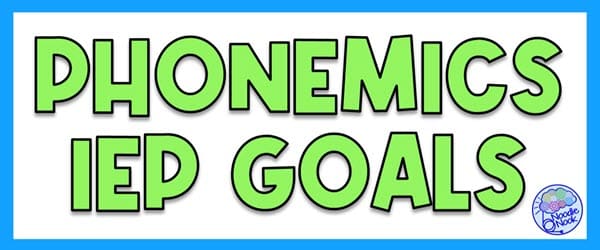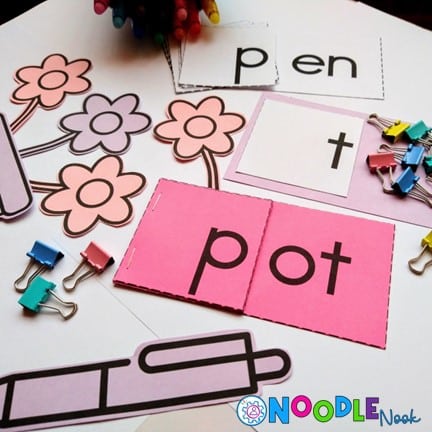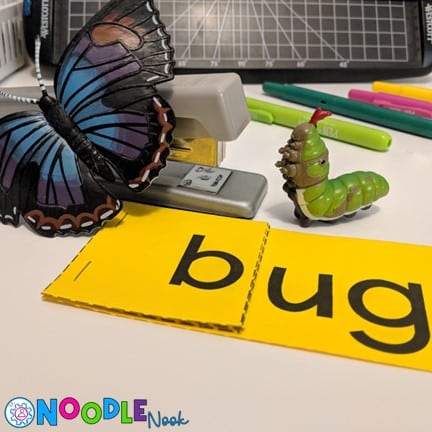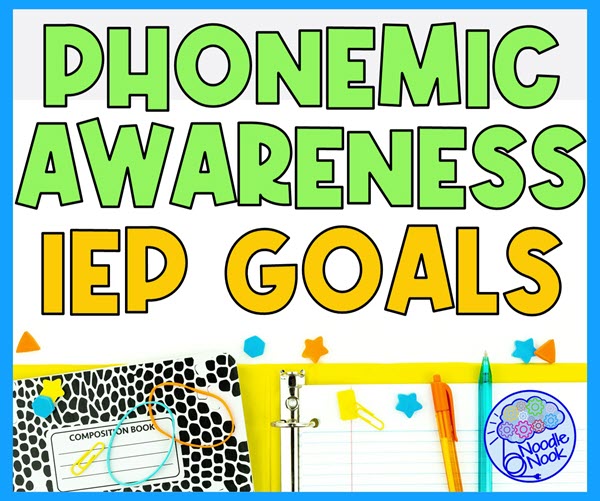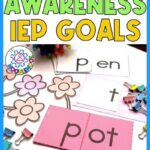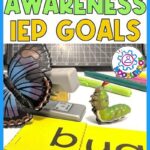Are you curious about what phonemic awareness is and why it’s important for reading and writing? Well, you’ve come to the right place! Phonemic awareness is the ability to hear, identify and manipulate the individual sounds (phonemes) in words. Phonological awareness skills are a crucial building block for reading and writing success, and that’s why it’s so important for students to develop this skill. In this post, we’re going to take a closer look at phonemic awareness IEP goals, strategies for teaching it, and how to measure progress toward these goals.
So, grab a cup of coffee, get comfortable and let’s dive in!
What is Phonemic Awareness
Phonemic awareness is the ability to hear, identify and manipulate the individual sounds (phonemes) in words. It is a crucial building block for reading and writing success, and is considered the foundation for learning to read and spell.
Phonemic awareness involves the ability to hear and distinguish the individual sounds in words, and then manipulate those sounds by adding, deleting, or substituting sounds in words to create new words. This skill is important because it helps students to understand that words are made up of separate sounds and that those sounds can be manipulated to create new words.
An example of this could be a student, who when given the word “cat”, is able to break it down into its individual sounds /k/ /æ/ /t/. The student can then manipulate these sounds by adding a sound, for example, changing the word to “bat” by adding a /b/ sound at the beginning, or “rat” by substituting the /k/ sound with a /r/ sound. He can also delete a sound, for example changing the word “cat” to “at” by deleting the /k/ sound. This ability to break down words into individual sounds and then manipulate them to create new words is a key component of phonemic awareness.
Developing phonemic awareness allows students across multiple grade levels to read better. This is because they understand words can be broken down into smaller units, including the smallest unit of sound, which is essential for learning to read and spell. Without developing the specific skill sets that support phonemic awareness, they may have difficulty learning to read, especially when they come across new or unfamiliar words. This is part of why writing sold IEP goals for students who have reading issues is so important. A student’s ability to work with different phonemes, blend sound, and segment sounds are critical.
Why Are Phonemic Awareness IEP Goals Important?
Phonemic awareness is like the secret weapon for reading and writing success, and that’s why it’s such an important part of our IEP goals for special education students. Setting a specific and measurable annual goal for our students’ phonemic awareness can help them become more confident readers and writers. These goals might include being able to segment words into individual sounds, blend sounds together to make words, identify the initial and final sounds of words, or even count the number of sounds in a word.
These goals might seem small, but achieving them can have a big impact on our students’ reading and writing abilities. And the best part is, teaching phonemic awareness can be a blast! Incorporating fun activities like rhyming games, sound hunts, and syllable clapping can make learning phonemic awareness skills feel more like playtime than work. So, let’s get creative and make phonemic awareness a fun and engaging part of our student’s journey to literacy development!
Examples of IEP Goals for Phonemic Awareness
Creating specific and measurable IEP goals for phonemic awareness is an important step in helping students with difficulties in this area to improve their reading and writing abilities. These goals should be tailored to the specific student’s needs and abilities.
This list of example IEP goals for phonemic awareness can be a great way to take your first step toward a meaningful goal. It can help guide you in creating goals for your own students, just make sure they are personalized to meet their needs. There’s a range of skills, including the ability to segment words into individual sounds, blend sounds together to make words, identify the initial and final sounds of words, count the number of sounds in a word and more in this IEP goal bank.
IEP Goal Bank
Each goal will be accompanied by a specific measure of success and a way to assess the student’s progress. That’s what keeps these measurable goals specific, plus they all address an essential skill that supports phonics skills. These sample IEP goals will serve as a starting point and can be adjusted to meet the specific needs of your student.
- Student will be able to segment words into individual phonemes with 80% accuracy, as measured by assessments such as the Phoneme Segmentation Fluency Test.
- Student will be able to blend phonemes together to form words with 70% accuracy, as measured by assessments such as the Phoneme Blending Fluency Test.
- Student will be able to identify the initial sound of words with 90% accuracy, as measured by assessments such as the Initial Sound Identification Test.
- Student will be able to identify the final sound of words with 90% accuracy, as measured by assessments such as the Final Sound Identification Test.
- Student will be able to identify and produce rhyming words with 80% accuracy, as measured by assessments such as the Rhyme Identification Test.
- Student will be able to change the initial sound of words to create new words with 75% accuracy, as measured by assessments such as the Sound Substitution Test.
- Student will be able to count the number of phonemes in a word with 90% accuracy, as measured by assessments such as the Phoneme Counting Test.
- Student will be able to demonstrate an understanding of syllables in words by clapping out the syllables in words with 80% accuracy.
- Student will be able to match the letter names and letter sounds when presented in a visual or auditory format with 90% accuracy.
- Student will identify the first sound in target sight words at a rate of 10 per week with 80% accuracy
- Students will blend CVC words or other simple words when given individual speech sounds
It’s important to note that these are examples and that the goals should be tailored to the specific student’s needs and abilities.
Reminders As You Write Goals
It’s also important to note that all the resources you use to teach and assess these goals should be kept age appropriate. Although this is a skill that often gets targeted in kindergarten and first grade, older students who struggle with their letter-sound knowledge may also have this as part of their targeted annual goals. Be sure to respect the chronological age of the students and keep their materials age appropriate. No student in a middle school classroom wants to work on different sounds with their speech-language pathologists or classroom teachers using ‘baby’ materials.
Also, the assessment method and the specific criteria for success should be clearly defined by the IEP team. Informal assessment works for assessing smaller components of the larger goal or specific part of phonological awareness tasks. For more formal instruction and assessments, try to identify the specific measure within the smart goals you write.
Goal Data Collection
Finally, as with all things special ed, as you are following goals and tracking progress throughout the school year, be sure to reassess regularly to determine if the goals continue to be appropriate for the student and if they are making progress. That type of active monitoring of language goals happens more than just at the annual review.
Special education teachers and case managers should be keeping a close eye on the goal areas related to reading skills to make sure students are on the right track. The important skills of phonemic awareness and how they support proficient readers cannot be overstated. Falling behind in this area can significantly impact a student’s future learning opportunities, so be vigilant.
Ways to Teach Phonemic Awareness
Teaching phonemic awareness can be fun when you know the right strategies! One of the most effective ways to teach phonemic awareness is through explicit instruction. Explicit instruction is one of the best practices with all instruction for students receiving special education services while addressing the general education curriculum. This is where the teacher directly teaches students about the individual sounds in words and how to manipulate them. It’s like giving your students a “Phoneme 101” class. Using this approach with a small group or during targeted language therapy makes the amount of time spent on instruction and remediation all the more powerful.
It may sound like a lot of work, but with the right activities and games, it can be a blast! Think sound hunts, rhyming bingo, and syllable clapping contests. There are so many options for how to support students so be understanding of different ways they prefer to learn and use activities that are interesting to them and engaging. Either way, with explicit instruction, your students will be breaking down words and manipulating sounds like pros in no time!
Activities for Phonemic Awareness
Practicing phonemic awareness can be a blast with the right activities! One way to do this is through interactive games and exercises that make learning fun. For example, you can use sound-to-letter matching activities, where students match a picture of an object with the initial sound it starts with.
Another fun activity is to play rhyming bingo, where students listen to words and match them to words on their bingo cards that rhyme. You can also use syllable clapping games, where students clap out the number of syllables in words and try to beat their own record.
One more way to practice phonemic awareness is through the use of technology, such as interactive phonemic awareness apps and games. These activities are not only fun, but they also help to build a strong foundation for reading and writing success, especially with visual learners.
Incorporating Phonics into Reading and Writing
When it comes to teaching phonemic awareness, why not kill two birds with one stone? Incorporating phonemic awareness into other reading and writing activities is a great strategy that can make learning fun and more engaging. For example, you can use word-building activities where students use letter cards to build words, and as they build, they say the sounds out loud.
You can also use word detective activities where students have to find words in a sentence that match a certain pattern (e.g. words that start with /b/ or have a specific medial sound).
Or you can use story dictation, where students dictate a story to you, and you write it down as they say it, while they focus on sounding out the words. These activities can make learning phonemic awareness more fun and interactive, while also helping students to improve their reading and writing skills at the same time. It’s a win-win!
Setting Up to Teach Phonemic Awareness
When it comes to setting up the right way to support phonemic awareness learning, there are a few keys. you’re not alone! There are plenty of resources available to support your instruction and make learning fun.
One way to do this is through independent work tasks or workstations. This is a great way for students to work on activities that reinforce the skills they’ve learned during explicit instruction, like with task cards. Or, you can include different interactive games and apps, worksheets, and other activities that are specifically designed to support phonemic awareness development.
Another great way to use resources is through small group instruction stations. This is where you can work with a small group of students to provide targeted instruction and practice for specific phonemic awareness skills. This is a perfect place to practice sound blend skills, including multi-syllabic words, syllable blending, working with compound words, or even demonstrating a knowledge of the meaning of each vocabulary word that’s being used in a reading or content area lesson. Small groups are fantastic for this.
Reading Centers
Finally, another way to support phonemic awareness is through reading centers. This is where you provide students with a variety of age-appropriate reading materials, and they can practice their phonemic awareness skills by sounding out words and working on word-building activities.
These centers can include different reading materials such as books, magazines, newspapers, and many more. To add more fun, you can also incorporate interactive reading games and activities like word matching and sound hunts.
With the right resources, your students will be well on their way to becoming better readers and writers. So, let’s get resourceful and make phonemic awareness learning a fun and engaging experience!
RECAP: Phonemic Awareness IEP Goals
And there you have it! We’ve covered the importance of phonemic awareness and how it’s a crucial building block for reading and writing success. We’ve also looked at how to set specific and measurable IEP goals for phonemic awareness, and how to use fun and interactive strategies to teach and practice phonemic awareness.
We can’t stress enough how important it is to address phonemic awareness through focused SMART goals during the IEP process. You can do this by targeting an appropriate goal that reflects the student’s present level and works toward functional literacy skills. By setting specific goals and providing targeted instruction, we can help our students with difficulties in this area to improve their reading and writing abilities.
When our students succeed in meeting their phonemic awareness goals, the benefits can be huge. They will become more confident readers and writers and will have an easier time decoding new words. That supports their success in the classroom and after graduation!
BONUS!! Are you looking for some testing tools to determine where your student may be struggling when it comes to reading? Your best bet is to head over to Dibels from the University of Oregon and grab their assessment materials. You’ll be glad you did.
Article Citation: [cite]